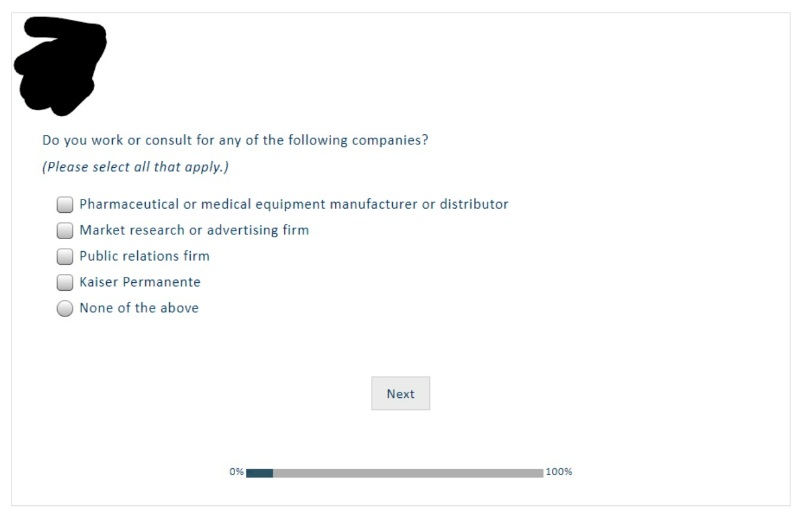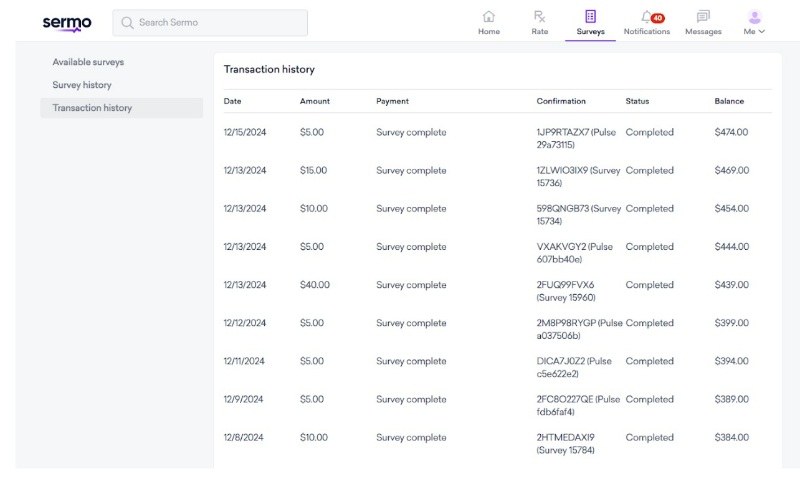
 By Dr. Rikki Racela, WCI Columnist
By Dr. Rikki Racela, WCI ColumnistOne of my most popular columns is when I told the story of making over $ 30,000 in surveys. Yes, incredible! In that vein, I have been asked by the WCI team to go in depth, with screenshots, on the process of doing physician surveys. Maybe it’s because people are skeptical. What follows is my step-by-step guide on how I come upon surveys, how I go through them, and how I optimize my 1099 income from surveys with a solo 401(k), including my newly minted ability to do the Mega Backdoor Roth.
Turns out, it’s all pretty darn easy.
#1 The E-Mail
I usually get an email about a survey, and this is the first notification that one is available. Some survey companies may text you, but only a few do that. My preferred notification is through email (I usually get 50-60 per month). Within the email is a link to click on, which brings you directly to the survey without having to go through any landing page. Here is an example of an email from Sermo (which is one of my biggest payers).
#2 The Screener
It seems this second step is probably the most frustrating for doctors because even though you might have gotten an email for a survey, this does not mean you actually qualify to participate and get paid. The email notification is a superficial blast email based solely on your specialty. But the screener ensures you don’t have any conflicts, including being licensed in Vermont (which makes it difficult for pharmaceutical products, biological products, and medical devices to give gifts to Vermont healthcare providers), having a family member that works in the survey industry, or having other conflicts as seen in the following screenshot.
The screener also makes sure you see a certain number of patients that the survey concerns. I am a neurologist who sees all types of neurological patients. I am fellowship-trained in clinical neurophysiology, where I learned to do EMGs and perform EEGs. Any rare neuromuscular or refractory epilepsy patients are part of my practice.
Due to my EMG training, I have special knowledge of all muscle locations, so I give Botox for spasticity. I also give Botox for chronic migraines. Many of my colleagues in my group refer MS patients to me since I have attended MS conferences and I am comfortable prescribing all FDA-approved MS treatments. Because of this, I rarely screen out of these surveys. Also, I can now recognize surveys that I will likely screen out of, including surveys regarding thrombectomy devices. When a screener, for example, asks, “How many thrombectomies and other surgical intracranial procedures have you performed?” I know not to continue to waste my time with that survey.
More information here:
Physician Side Gigs for Extra Income
#3 Doing the Survey
Now, I must emphasize that this side gig is lucrative for me (in the mid-five figures) because I really enjoy doing them. Most of the time, I do these surveys at night, when the wife and kids are asleep, and I go to my computer desk (for which I take my home office tax deduction), put on some 80s music, and do these surveys (which usually takes me an average of 25 minutes). As I write this column now, I have Milli Vanilli playing in the background (yes, you may make fun of me in the comments . . . blame it on the rain nostalgia), and after I am done writing this, I will be doing another survey with whatever other 80s song pops up on YouTube.
Online surveys require little mental energy, and I get to access some positive childhood memories through the music, utilizing my bilateral temporal lobes wherein lie auditory cortices to my dominant side limbic system structures (sorry, I couldn’t resist).
#3 Alternative: Doing a Zoom Survey
Another point of emphasis on why I made such a boatload of money with surveys is that I do the most lucrative ones in the form of live telephone or Zoom interviews. These usually last one hour, and I have been paid up to $ 400 an hour for just sitting on my tush talking about my opinions on future drugs being developed, different types of efficacy and safety data regarding a potential new therapy, or viewing future journal ads. Very easy money!
As long as you have access to a phone, you can do many of these highly paid surveys. Unfortunately, some companies ask that you do these surveys on a computer screen so you can view the material. To enforce this, some of the virtual software they use does not allow you to use your phone, an unfortunate downside since it’s not as flexible. Even worse, some popular virtual interview programs these companies use, including Forsta or Civicom, continually have problems working on my hospital’s internet. I am not sure, but I assume that because Forsta and Civicom are programmed to prevent you from doing a survey on your phone, it also creates problems doing an interview through a hospital firewall. I have always had a better interview experience without technical difficulties utilizing survey companies that do virtual interviews on the more common virtual programs like Zoom or Microsoft Teams.
#4 Get Paid
After I complete a survey, I sit back, relax, and wait for payment. The system I use to keep track of payments is quite easy and email-based. Because I learn about these survey opportunities through email, once I complete the survey, I place the email in a “completed surveys” folder in Gmail. Then, once I receive payment, I move the email into the “surveys paid” folder. Once in a while, I’ll check to see if there are still unpaid surveys in my “completed surveys” folder, and if I haven’t received payment after a couple of months, I follow up with the company.
Different companies offer different forms of payments—some of them give choices of either Amazon rewards, a variety of gift cards, a check, or PayPal. Some survey companies also have a portal if you want to keep track of how much a particular company has paid you, as seen in the screenshot below.
More information here:
How to Actually Get Paid as an Expert Witness (or Any Other Side Gig)
#5 Contribute to Your Solo 401(k)
Wait, you’re not done yet! All that 1099 income qualifies for placing a percentage of it as an employER contribution to your solo 401(k). Now, if you only have a couple thousand dollars of survey income, maybe it’s not worth it to set up a solo 401(k) since you can only have about 20% of your 1099 income eligible to be placed as a tax-deferred contribution. However, if you have $ 10,000 or more of survey income (and also any other 1099 income), that’d be starting to get in the thousands of dollars of tax benefit. That’s when it’s starting to be worth it.
My solo 401(k) was started at Fidelity and was super simple to create, and for the past five years, I was making my employER contribution before Tax Day of the following year. You have to calculate your contribution based on all 1099 income and plug it into an equation that roughly but not exactly equals 20% of earned income. The equation is:
(Self-employment compensation – deductible portion of self-employment tax) / (1 + contribution percentage).
It’s kind of a circular equation, so it’s much easier for somebody who does their own taxes to use Mike Piper’s calculator. Or you can be like me and ask your accountant to do it for you.
2024 was the first year that I did the Mega Backdoor Roth with my survey income. That year, I asked the company My Solo 401(k) Financial to set up a customized solo 401(k) that allows tax-deferred and post-tax contributions, as well as allowing rollovers to the Roth portion of the solo 401(k) or external rollovers to my Roth IRA. My Solo 401(k) Financial was able to keep this customized solo 401(k) at Fidelity. Before Tax Day, I made my usual calculated employER tax-deferred contribution as well as post-tax contributions to my solo 401(k). Because I have a 403(b) at my W-2 job, that retirement plan money unfortunately ate into the solo 401(k) limit of $ 69,000, but hey, I still get to put thousands more into a Roth.
There you have it. That’s my system for making a whole bunch of dough doing easy paid surveys, how I keep track of payments, and how to contribute to tax-advantaged accounts. I am so happy to have a lucrative extra source of income that’s easy and that I enjoy. It’d be easy for you to do it, too.
As a doc, you have valuable knowledge and information. Various companies want that knowledge and are willing to pay you for it. If you’re interested in starting a side hustle as a paid survey-taker while also making a difference in the medical field, check out our favorite physician survey companies today!
Have you taken any paid surveys? Have there been survey emails that you just ignored? How do you take advantage of paid surveys?
The post Physician Surveys Step by Step (And Why Making $ 30,000 in a Year Was Easy) appeared first on The White Coat Investor – Investing & Personal Finance for Doctors.
The White Coat Investor – Investing & Personal Finance for Doctors





